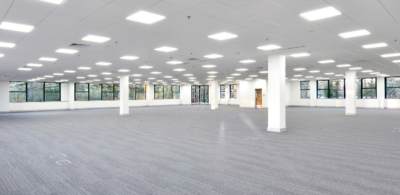In the first article of this three-part series discussing how law firms can leverage a lease event as a catalyst for change, we identified disruptors transforming the law firm office. In part two, we explore the best practices forward-thinking firms are embracing.
Law firm design has functioned on essentially the same model for the last 100 years. What do you think of when you picture a law firm? You probably imagine a large office replete with dark, paneled wood and quiet spaces, dim hallways, administrative support stationed one per attorney, custom desks supporting previous generations of attorneys, desktops overloaded with paper, outdated kitchen areas, offices without windows and large conference rooms as the only form of a communal space.
The traditional law office restricts opportunities for learning, mentoring and engagement and appeals to neither new talent nor next-generation clients. As the industry shifts, so must the workplace. To support transformational shifts, progressive firms are creating new workplaces with seven key design criteria in mind: right-sizing, healthy workplaces, mobility support, futureproofing, curating experience, technology integration and messaging.
Right-size. Work Design Magazine notes, “Using space efficiently will become increasingly important to maximize company assets while offering flexible environments that meet the needs of permanent office inhabitants and mobile workers alike.” Every square foot is important. Eliminating libraries and unnecessary paper storage can be key to increased efficiency. Gensler notes that firms can decrease their total space by 15-40% through strategies including “universal office sizes, wall-less offices and mobility programs,” and still increase headcount. Colliers’ recent report concurs, citing a 6% reduction in space allocation for legal professionals in just the past 18 months. However, where law firms are moving to new premises, or renewing in place, the reduction in footprint can be greater. While greater economies of scale are achieved by some firms, the reduction in footprint is typically in the range of 10-20%. With the growing adoption of Legal Process Outsourcing (LPO), remote workers can result in cost savings on the cost of physical space — usually the second highest expense for a law firm.
Healthy Work Environments. A workplace designed to intentionally support human performance is key to engagement, productivity and cognition. Over the past decade, organizations such as the International WELL Building Institute have rigorously researched the impact of the built environment on health, focusing on air, water, nourishment, light, fitness, comfort and mind.
Recently, Nelson Worldwide explored design strategies specific to supporting wellness in the legal industry. Significant recommendations include providing daylight and views for everyone, good air quality, biophilic design features that incorporate natural materials, plants and organic shapes and patterns. Additionally, sit-to-stand desks, inspiring stairways and “active design” principles can be applied to encourage movement. Finally, providing choices through a variety of spaces supports concentration, restoration, connection, learning and collaboration.
Supporting Mobility. Today’s workforce wants the ability to work from anywhere, and when they come into the office, they like the wide variety of work environments mentioned above. As a Gensler report notes, “Mobility is about options, not giving up their desks.” Mobile technology enables employees to move easily from private offices to casual meeting spaces to in-office cafes and dining areas, facilitating collaboration with clients and coworkers. Robust technology tools and platforms can offer attorneys and staff options for working from home, satellite offices and other workplaces. But enabling remote, mobile work must be seen as just one option in a set of options. Working together physically, at least part of the time, is still essential to drive innovation, processing information and knowledge transfer.
Futureproofing. Given the costs of real estate and the length of many leases, a successful workplace strategy must serve today’s needs while minimizing barriers to meeting future needs in this rapidly evolving industry. Multi-purpose, reconfigurable rooms are key to achieving design efficiency. Universal offices — offices that can be used as private workspaces and small meeting rooms — provide agility as firms accommodate both company and client needs.
Large community reception spaces serve multiple purposes: community events, client meetings and receptions, board and company meetings and video conferencing. Demountable walls and smart design allow these large spaces to transform into smaller training and meeting rooms.
Lighter, reconfigurable furniture can also leave a smaller footprint, provide a more modern impression of the firm’s brand and make space adjustments quick and easy. Modular building components can reduce the cost of reconfiguration by as much as 60%.
Curating Experience. The best workplaces create experiences for employees and clients that are engaging and productive. Using glass walls to provide higher levels of transparency help people connect, supporting higher levels of engagement. Mentorship becomes a natural occurrence when spaces help both seasoned attorneys and young associates to “be seen.” Spaces that encourage legal workers to interact with each other instead of in silos allows them to build social cohesion and transfer knowledge.
Curating an exceptional work experience requires an integrated approach partnering with facilities, IT, human resources and others. Some firms are introducing elements of hospitality in an effort to remove friction from employee’s work lives and creating memorable experiences for visiting clients. This requires support and modeling from firm leadership to fund and drive the evolution. Not only will this strategy support engagement but it will increase retention and help build a positive workplace culture.
Tech-integrated. The modern law office is cloud-connected and technology-supported. The legal workforce must be able to access documentation with a push of a button, store information securely and create efficiencies by utilizing new legal technologies.
Additionally, virtual law services are much more common, and virtual work isn’t just for lawyers. For support staff, mobility might mean working offsite, in another city and even country. Technology that supports virtual staff, including video monitoring and meeting programs, and project management software, is becoming increasingly necessary.
Messaging. Integrating your brand is more than a logo in the entry and the firm colors on the wall. Progressive law firms are leveraging their workplace strategy to authentically capture the brand, values and culture of the firm into the design. Many firms today are creating a more modern aesthetic that represents a future-focused vision, one that leverages real estate wisely and weaves in their values such as transparency, equity and commitment to the community and environment. Firms can stand out by being deliberate about the messages the design of their spaces send to clients and potential talent.
Legal work environments that mindfully address these seven factors save money and resources, capture the attention of potential clients, attract talent of all types and increase positive workplace interactions. A case study at Nixon Peabody, a global law firm in Washington, D.C., found that design changes produced many significant benefits: costs and resource were reduced by one third; space utilization improved; collaboration and interaction increased, producing better work outcomes; reports of employee wellbeing rose; and brand values, including sustainability, entrepreneurship and community support, were represented. Legal workers were happier to come to work and better at their jobs — all because of better workplace design.
Next in this three-part series, we conclude with the questions clients need to ask themselves to align their workplace with their vision and identify the best ways to strategically leverage lease events as a catalyst for law firm evolution.

 Colliers Insights Team
Colliers Insights Team

 Aaron Jodka
Aaron Jodka
 Amber Merrigan
Amber Merrigan
 Andrew Steele
Andrew Steele